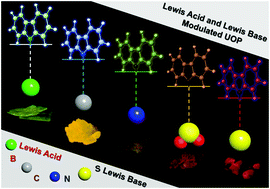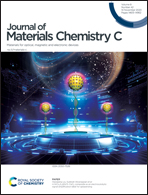Tunable ultralong organic phosphorescence modulated by main-group elements with different Lewis acidity and basicity†
Abstract
A series of ultralong organic phosphorescence (UOP) materials (XCz-Cm/Lab, X = B, C, N, and S) with tunable UOP colors and lifetimes through the combination of commercial/lab-synthesized carbazole (Cz-Cm/Lab) with the Lewis acidic or Lewis basic main-group elements is reported. With the increasing Lewis basicity from boron to carbon, nitrogen and sulfur in scaffolds, the corresponding lowest triplet excited state energy levels of the XCz gradually decreased, and the UOP colors of XCz-Cm showed a bathochromic shift from yellow-green (∼534 nm) to orange-red (∼580 nm). Conversely, the distances of π–π interaction of the XCz molecules and the radiative decay from the lowest triplet excited state to the ground state gradually increased, endowing the XCz-Cm with tunable UOP lifetimes (0.068–0.555 s). The XCz-Lab exhibited similar photoluminescence behavior as XCz-Cm, and the difference between XCz-Cm and XCz-Lab was attributed to the isomer of Cz-Cm. Owing to the long-lived triplet excited states, the CCz-Cm nanoparticles were applied in real-time lymph node afterglow imaging through intravenous injection in vivo successfully. This contribution not only presents a new versatile strategy for modulating UOP properties by introducing Lewis acidic/basic main-group elements but also extends their applications in afterglow imaging.



 Please wait while we load your content...
Please wait while we load your content...